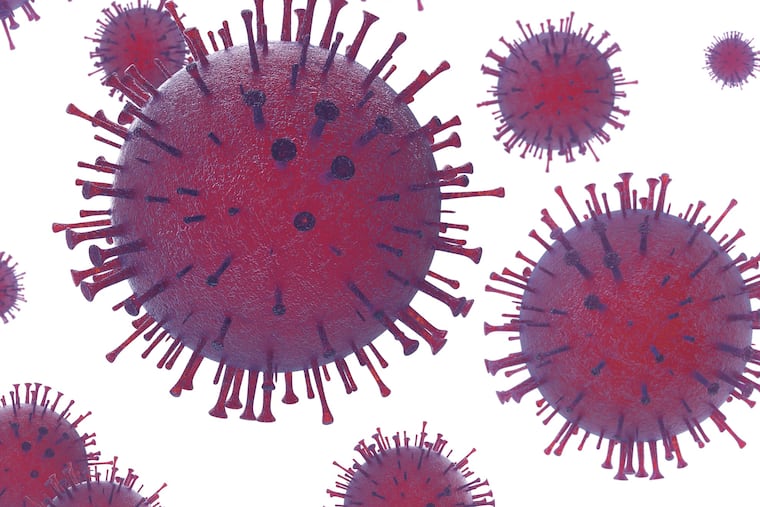Penn’s genital herpes vaccine is a winner in animals. Next up: Testing on humans.
The novel immunization not only completely prevented genital sores, it also was almost totally effective at keeping the virus from going into hiding in nerve roots.

For nearly a century, efforts to develop a vaccine to prevent genital herpes have failed. At least nine prospects, including several that made it to late-stage human testing, have flopped in the last decade.
Considering that history, University of Pennsylvania scientists are justifiably excited about their vaccine against the herpes simplex 2 virus, even though the latest results, published last month, are from animals.
The novel immunization not only completely prevented genital sores in mice and guinea pigs, it also was almost totally effective at keeping the virus from going into hiding in nerve roots — where it creates a symptomless infection that can still be transmitted.
In an earlier study, the Penn vaccine stimulated a robust immune response and prevented infection in rhesus monkeys, although only two were treated.
“What we have is close to perfect in animals. No one else has done that,” said Harvey M. Friedman, the infectious disease specialist leading the Penn research. “The big unknown is whether it will work in humans.”
As he well knows, lots of drugs that look promising in animal models of human disease are duds in human testing.
Genital herpes, which is usually caused by herpes simplex 2, is extremely common, partly because people with no symptoms can release the virus through their skin, spreading it to sexual partners. About one in five U.S. adults and teens has had a genital herpes infection, studies show. Even when the hallmark genital blisters don’t appear, the stigmatizing condition can cause anxiety and isolation. And a genital infection passed to an infant before, during or after birth can cause disability or death.
A vaccine is “urgently needed,” Friedman’s group has written.
» READ MORE: Sexually transmitted diseases hit record high nationally; Philly is even worse
Most conventional vaccines are made from live virus that is weakened or inactivated so it stimulates an immune attack without causing infection. Newer approaches involve injecting genetic material — in the form of DNA or RNA — that is taken up by cells and translated into proteins that activate parts of the immune system.
The Penn vaccine produces three types of proteins: one blocks the virus from entering the cell and replicating, and two foil the microbe’s ability to evade the immune system.
» READ MORE: Many young women and teens think STDs can't happen to them
A downside of RNA vaccines is that the body quickly breaks down the RNA. Penn’s herpes vaccine slows down this degradation by packaging the RNA in a protective fatty acid — a lipid nanoparticle — that is naturally drawn into cells.
This delivery technology, pioneered by Friedman’s infectious disease colleague Drew Weissman, is also being used to develop RNA vaccines against pathogens such as the flu and Zika viruses. Last fall, Penn announced a collaboration with BioNTech, a German biotechnology company, to research and commercialize the immunizations.
“Drew and his research group are spearheading truly novel vaccine concepts for the prevention of infectious disease,” BioNTech CEO and co-founder Ugur Shin said in announcing the partnership.
The genital herpes vaccine results were published in the journal Science Immunology. Researchers gave the shots to 64 mice and 10 guinea pigs before exposing them to the virus. None of the animals developed the genital sores that signal clinical infection. But more important, tests done over a month found that 63 mice and 8 guinea pigs had no sign of subclinical infection — the symptomless kind that can still be spread.
“No genital herpes vaccine has prevented both clinical and subclinical infection,” Friedman’s team wrote.
The two guinea pigs that did develop subclinical infection produced so little viral DNA that “we couldn’t grow the virus [in a lab dish] from those particles,” Friedman said. “So we think the risk of transmission is very low.”
The next big step is to get permission from the U.S. Food and Drug Administration to begin human testing.
“I’ve had informal discussions [with FDA officials] at scientific meetings,” Friedman said. “They’re really interested in this technology. I don’t think that will be a stumbling block.”
Clinical trials could easily take eight years, so even if the vaccine protects humans, it won’t be on the market any time soon. At age 75, having worked 44 years to understand the herpes virus and how to thwart it, Friedman has no plans to retire.
“I’d like to still be around,” he said. “I think we have a solid chance of making this work. But we won’t know until we try.”